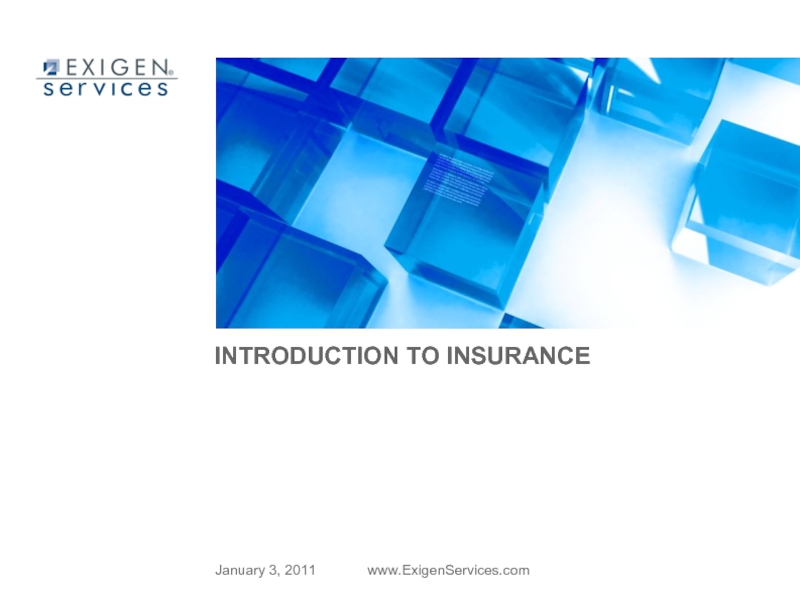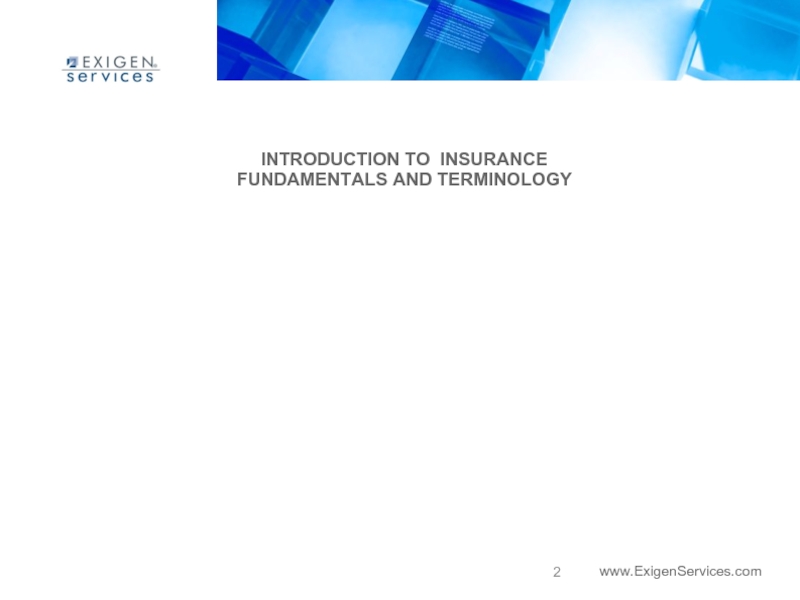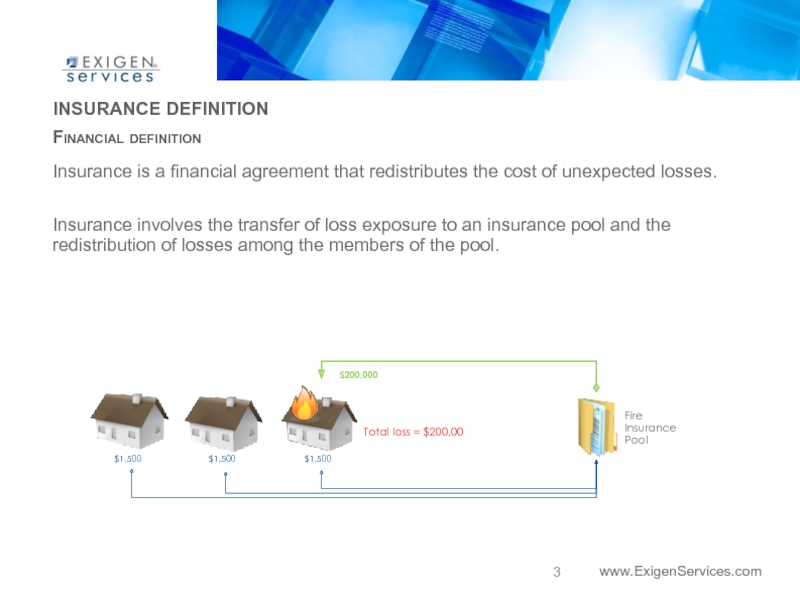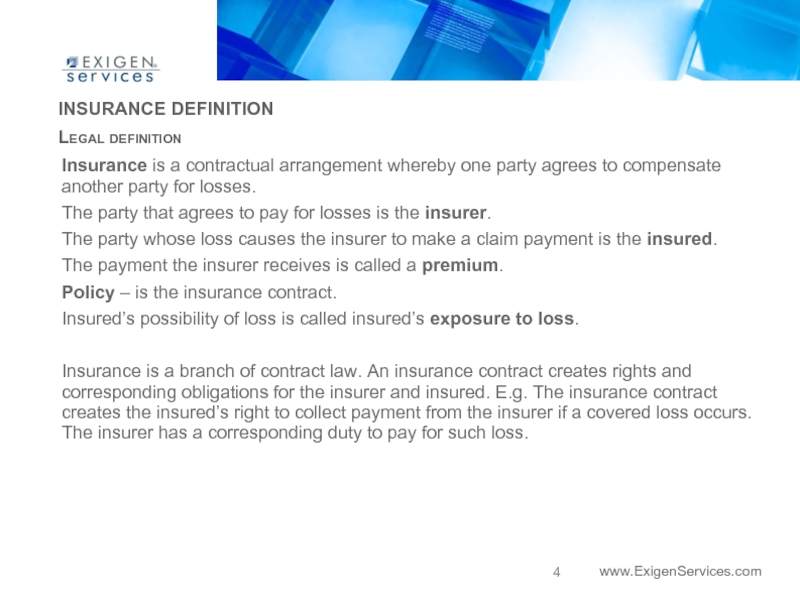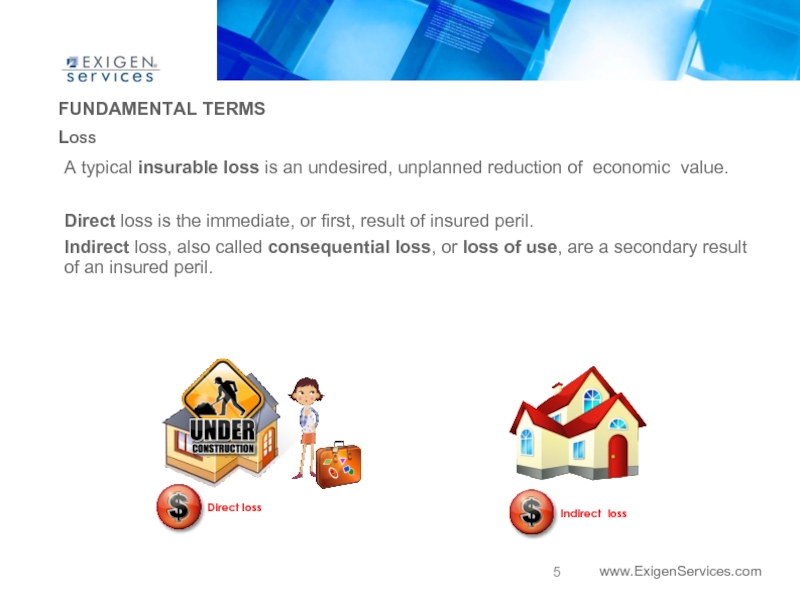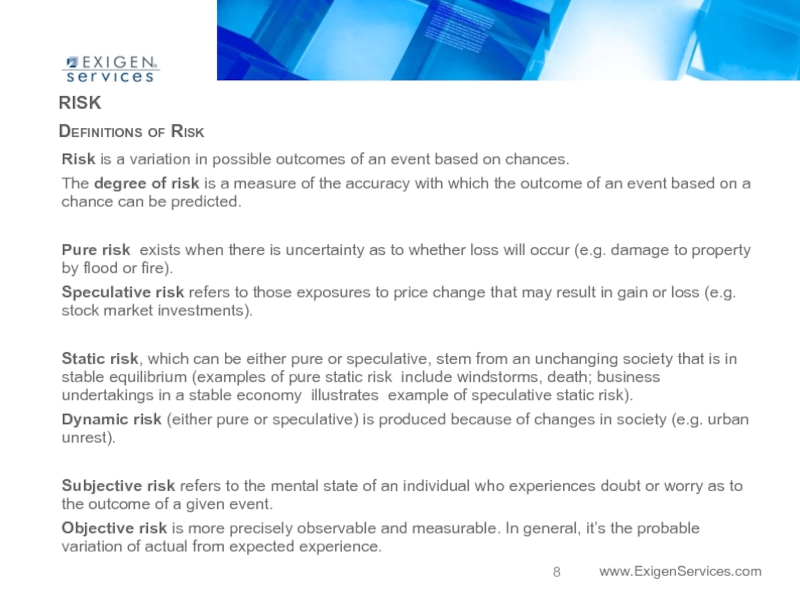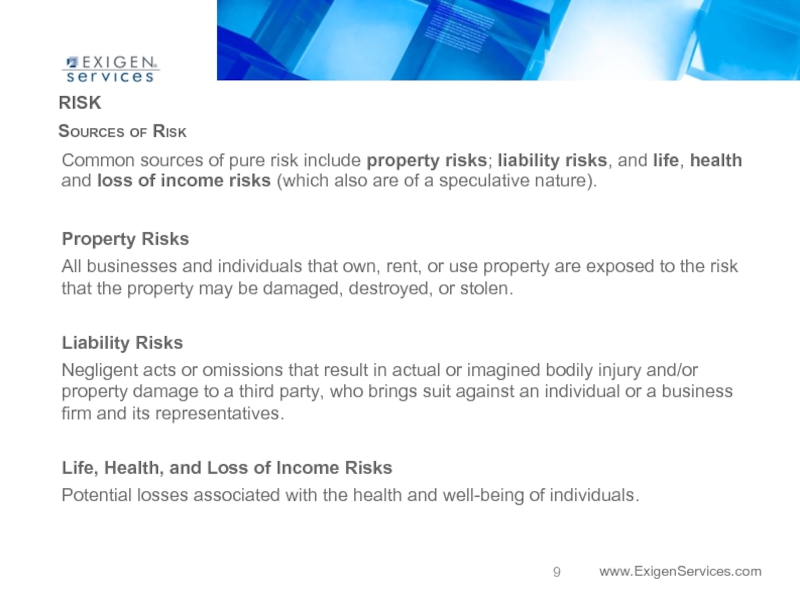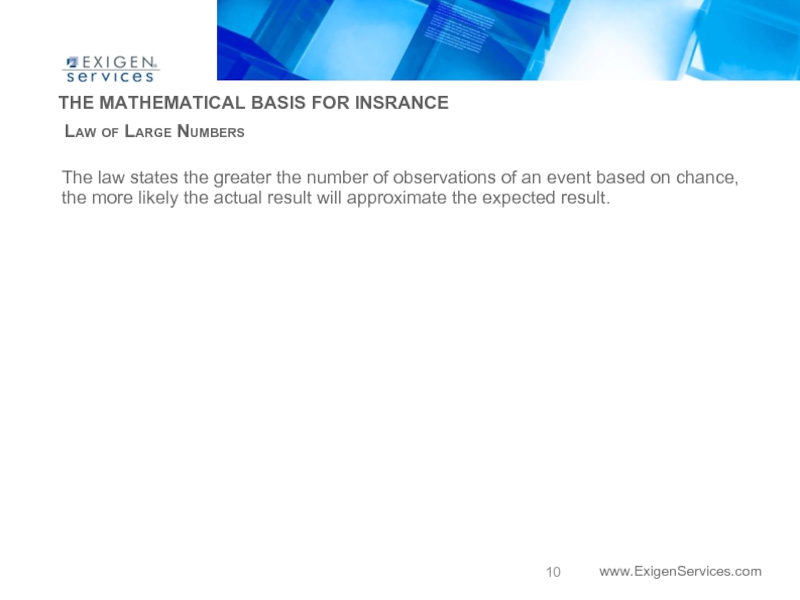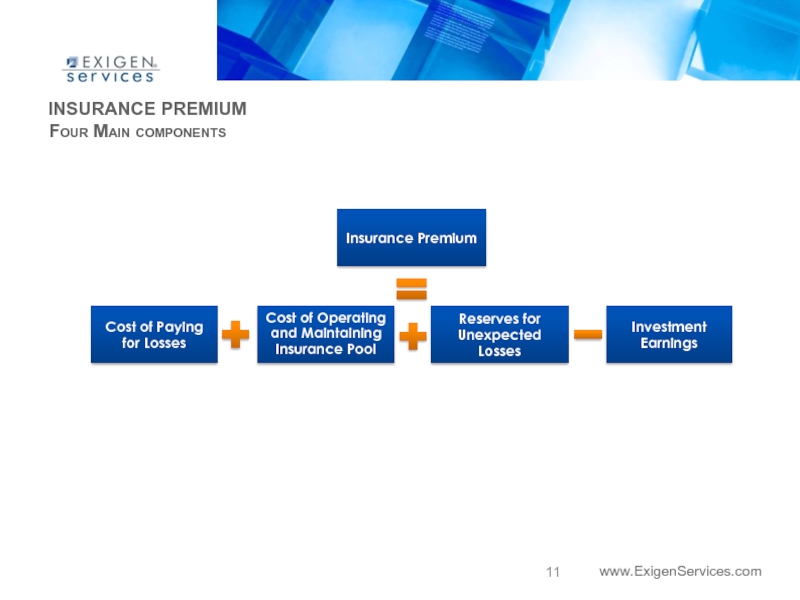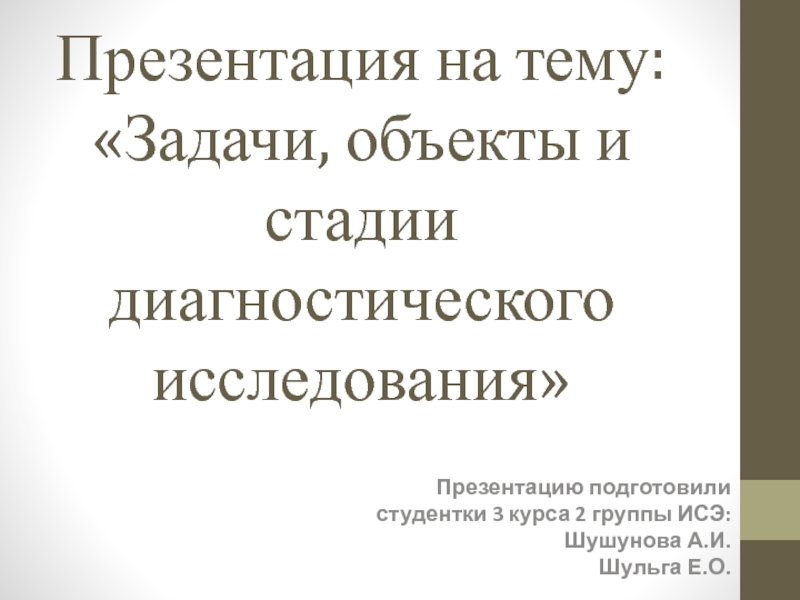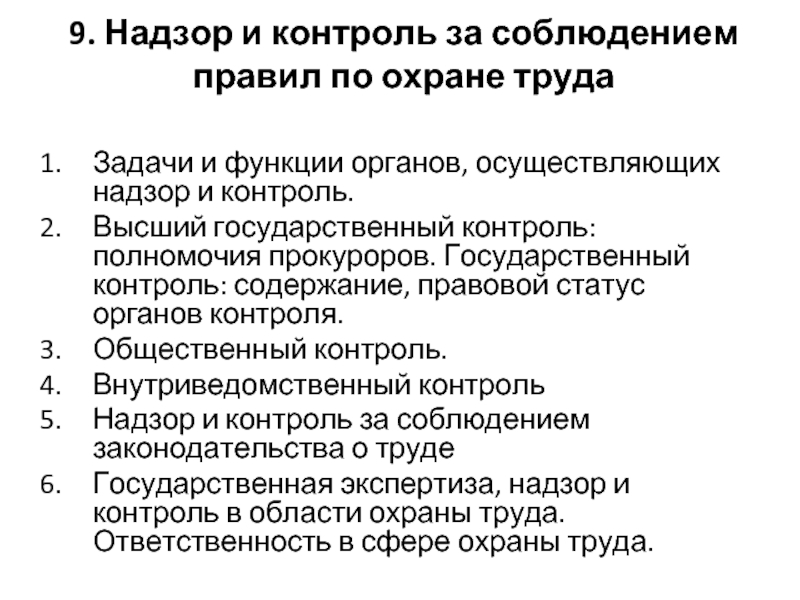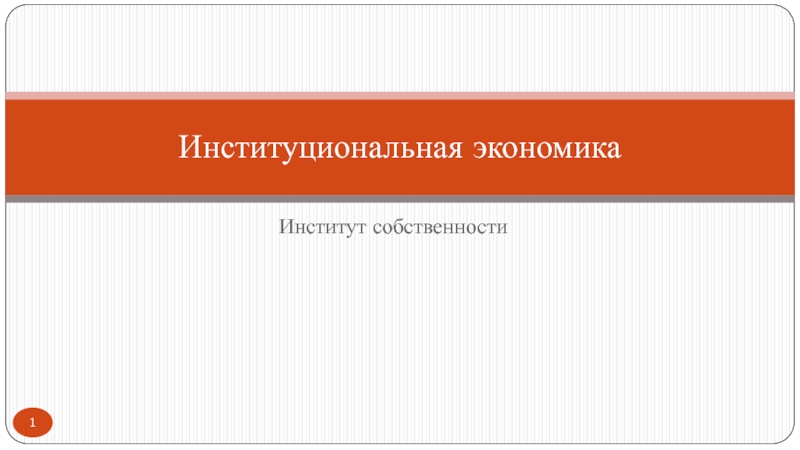- Главная
- Разное
- Дизайн
- Бизнес и предпринимательство
- Аналитика
- Образование
- Развлечения
- Красота и здоровье
- Финансы
- Государство
- Путешествия
- Спорт
- Недвижимость
- Армия
- Графика
- Культурология
- Еда и кулинария
- Лингвистика
- Английский язык
- Астрономия
- Алгебра
- Биология
- География
- Детские презентации
- Информатика
- История
- Литература
- Маркетинг
- Математика
- Медицина
- Менеджмент
- Музыка
- МХК
- Немецкий язык
- ОБЖ
- Обществознание
- Окружающий мир
- Педагогика
- Русский язык
- Технология
- Физика
- Философия
- Химия
- Шаблоны, картинки для презентаций
- Экология
- Экономика
- Юриспруденция
Introduction to insurance. ExigenServices презентация
Содержание
- 1. Introduction to insurance. ExigenServices
- 2. INTRODUCTION TO INSURANCE FUNDAMENTALS AND TERMINOLOGY
- 3. INSURANCE DEFINITION Insurance is a financial agreement
- 4. INSURANCE DEFINITION Legal definition Insurance is
- 5. FUNDAMENTAL TERMS Loss A
- 6. FUNDAMENTAL TERMS Chance of Loss
- 7. FUNDAMENTAL TERMS Peril and Hazard. Proximate cause
- 8. RISK Definitions of Risk Risk is
- 9. RISK Sources of Risk Common sources of
- 10. THE MATHEMATICAL BASIS FOR INSRANCE Law of
- 11. INSURANCE PREMIUM Four Main components Cost
Слайд 3INSURANCE DEFINITION
Insurance is a financial agreement that redistributes the cost of
unexpected losses.
Insurance involves the transfer of loss exposure to an insurance pool and the redistribution of losses among the members of the pool.
Insurance involves the transfer of loss exposure to an insurance pool and the redistribution of losses among the members of the pool.
Financial definition
Total loss = $200,00
$1,500
$1,500
$1,500
$200,000
Слайд 4INSURANCE DEFINITION
Legal definition
Insurance is a contractual arrangement whereby one party agrees
to compensate another party for losses.
The party that agrees to pay for losses is the insurer.
The party whose loss causes the insurer to make a claim payment is the insured.
The payment the insurer receives is called a premium.
Policy – is the insurance contract.
Insured’s possibility of loss is called insured’s exposure to loss.
Insurance is a branch of contract law. An insurance contract creates rights and corresponding obligations for the insurer and insured. E.g. The insurance contract creates the insured’s right to collect payment from the insurer if a covered loss occurs. The insurer has a corresponding duty to pay for such loss.
The party that agrees to pay for losses is the insurer.
The party whose loss causes the insurer to make a claim payment is the insured.
The payment the insurer receives is called a premium.
Policy – is the insurance contract.
Insured’s possibility of loss is called insured’s exposure to loss.
Insurance is a branch of contract law. An insurance contract creates rights and corresponding obligations for the insurer and insured. E.g. The insurance contract creates the insured’s right to collect payment from the insurer if a covered loss occurs. The insurer has a corresponding duty to pay for such loss.
Слайд 5FUNDAMENTAL TERMS
Loss
A typical insurable loss is an undesired, unplanned reduction
of economic value.
Direct loss is the immediate, or first, result of insured peril.
Indirect loss, also called consequential loss, or loss of use, are a secondary result of an insured peril.
Direct loss is the immediate, or first, result of insured peril.
Indirect loss, also called consequential loss, or loss of use, are a secondary result of an insured peril.
Direct loss
Indirect loss
Слайд 7FUNDAMENTAL TERMS
Peril and Hazard. Proximate cause
A peril is defined as the
cause of the loss.
Hazards are conditions that increase the frequency or the severity of losses.
If an individual causes or exaggerates a loss to collect insurance proceeds, this is insurance fraud, and the loss result from the moral hazard, which is an individual’s mental attitude.
Morale hazard refers to an attitude of carelessness or indifference to loss created by the purchase of an insurance contract.
Insurance contracts do not cover losses cased by an insured’s fraud.
Hazards are conditions that increase the frequency or the severity of losses.
If an individual causes or exaggerates a loss to collect insurance proceeds, this is insurance fraud, and the loss result from the moral hazard, which is an individual’s mental attitude.
Morale hazard refers to an attitude of carelessness or indifference to loss created by the purchase of an insurance contract.
Insurance contracts do not cover losses cased by an insured’s fraud.
Слайд 8RISK
Definitions of Risk
Risk is a variation in possible outcomes of an
event based on chances.
The degree of risk is a measure of the accuracy with which the outcome of an event based on a chance can be predicted.
Pure risk exists when there is uncertainty as to whether loss will occur (e.g. damage to property by flood or fire).
Speculative risk refers to those exposures to price change that may result in gain or loss (e.g. stock market investments).
Static risk, which can be either pure or speculative, stem from an unchanging society that is in stable equilibrium (examples of pure static risk include windstorms, death; business undertakings in a stable economy illustrates example of speculative static risk).
Dynamic risk (either pure or speculative) is produced because of changes in society (e.g. urban unrest).
Subjective risk refers to the mental state of an individual who experiences doubt or worry as to the outcome of a given event.
Objective risk is more precisely observable and measurable. In general, it’s the probable variation of actual from expected experience.
The degree of risk is a measure of the accuracy with which the outcome of an event based on a chance can be predicted.
Pure risk exists when there is uncertainty as to whether loss will occur (e.g. damage to property by flood or fire).
Speculative risk refers to those exposures to price change that may result in gain or loss (e.g. stock market investments).
Static risk, which can be either pure or speculative, stem from an unchanging society that is in stable equilibrium (examples of pure static risk include windstorms, death; business undertakings in a stable economy illustrates example of speculative static risk).
Dynamic risk (either pure or speculative) is produced because of changes in society (e.g. urban unrest).
Subjective risk refers to the mental state of an individual who experiences doubt or worry as to the outcome of a given event.
Objective risk is more precisely observable and measurable. In general, it’s the probable variation of actual from expected experience.
Слайд 9RISK
Sources of Risk
Common sources of pure risk include property risks; liability
risks, and life, health and loss of income risks (which also are of a speculative nature).
Property Risks
All businesses and individuals that own, rent, or use property are exposed to the risk that the property may be damaged, destroyed, or stolen.
Liability Risks
Negligent acts or omissions that result in actual or imagined bodily injury and/or property damage to a third party, who brings suit against an individual or a business firm and its representatives.
Life, Health, and Loss of Income Risks
Potential losses associated with the health and well-being of individuals.
Property Risks
All businesses and individuals that own, rent, or use property are exposed to the risk that the property may be damaged, destroyed, or stolen.
Liability Risks
Negligent acts or omissions that result in actual or imagined bodily injury and/or property damage to a third party, who brings suit against an individual or a business firm and its representatives.
Life, Health, and Loss of Income Risks
Potential losses associated with the health and well-being of individuals.
Слайд 10THE MATHEMATICAL BASIS FOR INSRANCE
Law of Large Numbers
The law states the
greater the number of observations of an event based on chance, the more likely the actual result will approximate the expected result.
Слайд 11INSURANCE PREMIUM
Four Main components
Cost of Paying for Losses
Cost of Operating and
Maintaining Insurance Pool
Reserves for Unexpected Losses
Investment Earnings
Insurance Premium
